Westerbork camp
Westerbork was the Dutch transit camp for the deportations of Jews in particular to the concentration and/or extermination camps Auschwitz, Sobibor, Bergen-Belsen and Theresienstadt.

De hoofdweg door kamp Westerbork. Langs deze weg lag de spoorweg en vertrokken de treinen, vanaf de zogenaamde 'Rampe', naar de concentratie- en vernietigingskampen in het oosten.
Vervaardiger onbekend. Herinneringscentrum Kamp Westerbork Copyright: Status onduidelijk
Westerbork functioned from October 1939 as a refugee camp for German-Jewish refugees who had come to the Netherlands, especially after Kristallnacht.[1] After the capitulation in May 1940, the management of the camp remained in Dutch hands for the time being, but the regime became stricter.[2]
On 1 July 1942, the camp was officially handed over to the German authorities. Westerbork was now officially called Polizeiliches Judendurchgangslager under the authority of the Befehlhaber der Sicherheitspolizei und Sicherheitsdienst (BdS) and the Reichssicherheitshauptamt (rsha). From that date, the camp was part of the extensive system of German concentration camps and functioned as an important transit point for the systematic murder of Jews from the Netherlands.[3]
From 15 July 1942, over 100,000 Jews were shipped from the camp to concentration and/or extermination camps: Auschwitz-Birkenau, Sobibor, Bergen-Belsen and Theresienstadt. Sometimes stops were made along the way to drop men off at German labour camps. In addition to Jews, Westerbork also held Roma, Sinti and sometimes resistance fighters.
At the head of Westerbork from 13 October 1942 was camp commander ss-Obersturmführer Albert Konrad Gemmeker (1907-1982). In March 1944, Gemmeker was commissioned to make a film about the camp, in which he wanted to show how well and efficiently the camp was organised.[4] This film shows a clear propagandistic picture of the functioning of Westerbork transit camp. Five months after the film was made, the eight people from the Secret Annex also ended up in Westerbork.[5]
The last transport from Westerbork was on 4 September 1944. The remaining prisoners were imprisoned until the liberation of the camp on 12 April 1945.
Footnotes
- ^ See the website van Herinneringscentrum Kamp Westerbork: .
- ^ Bas von Benda-Beckmann, Na het Achterhuis. Anne Frank en de andere onderduikers in de kampen, Amsterdam: Querido, 2020, p. 69.
- ^ Von Benda-Beckmann, Na het Achterhuis, p. 59; Frank van Riet, De bewakers van Westerbork, Amsterdam: Boom, 2016, p.27-62; Jacques Presser, Ondergang. De vervolging en verdelging van het Nederlandse Jodendom, 1940-1945, ’s-Gravenhage: Aspekt, 1965, deel II, p. 295-296.
- ^ The film was shot by inmate Rudolf Breslauer (1903-1945). The shooting started at 5 March 1944. The film is preserved in the archive of Beeld en Geluid.
- ^ Von Benda-Beckmann, Na het Achterhuis, p. 73.